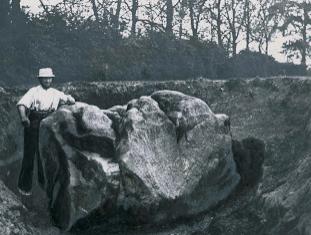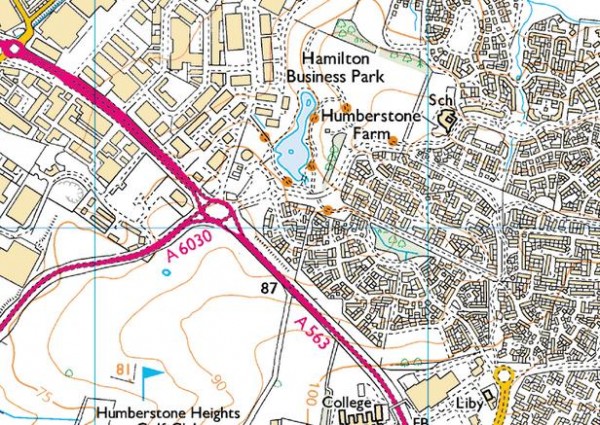The story of the Humber Stone (aka Hoston Stone) begins in 1841 with a letter: thanks to Beachcombing for these sources and advice.
In the lordship of Humberston, on the estate of Mr. Poohin, of Barkby, and about a mile N.W. of the parish church, there is a stone which is interesting from the traditions in the village concerning it. These traditions, though now almost lost, relate that fairies dwell in and near to it; that any injury done to it was sure to be followed by misfortune to the injurer, for that it was holy. This supposed sanctity is intimated by the name (Hostone) of the plot of ground where it is located… The stone is of the granite, or rather syenite rocks of Mountsorrel, about six miles distant, and seems to be one of the blocks which geologists term erratic blocks, many of which have been found in the lordship of Humberston, as also in the intervening distances between Humberston and Mountsorrel. This stone appears to be larger than any others now known. At present it is covered over by the turf of the field ; but about a hundred years ago it stood in a surrounding hollow basin, which the then owner of the land filled up, and broke off fragments from the stone, so that the plough might pass over it. The threat against injuries of the stone was certainly fulfilled in this instance; for the man, though born heir to a good yeoman’s estate, became a vagabond, and died in the parish workhouse (Allies 369).
Colin Wilson takes the story forward.
A huge ancient stone called the Humber Stone, near my home town, Leicester, as similar legends associated with it. It is also known as the Hell, Holy and Host stone, the last two suggesting it was once used for ritual purposes. It is believed to have been washed down the valley of the River Soar by an ice-age glacier. At the time of writing [1981] the Leicester planning authorities are thinking of building a housing estate around the site of the stone, and the Old Humberstone Historical Society has been approached about the possibility of excavating it and superintending its removal. In the Leicester Mercury, Mrs J. Bailey of the Society is quoted as saying that the Society doesn’t want to excavate because of what has happened to others. She speaks of a young man who placed a clock on top of the stone – and it promptly stopped; a clockmaker could find nothing mechanically wrong with it, but it still refused to start. Mrs Bailey had an interesting suggestion about moving the stone: ‘Talk to it. I believe that if you told it that it would be removed to a safe place where no damage would come to it, there would be not trouble. I believe there would be disastrous results otherwise… The article mentions events that sound similar to the ‘curse’ on the Irish stone circles: in the nineteenth century, William Pochin of Barkby investigated the Humber Stone, and then had an accident with a firearm in which he blew off half his hand. The farmer who owned the land allowed his plough to break off parts of the stone in the eighteenth century; legend has it that he never again prospered and died in the workhouse. A curate who covered over the stone (it was almost totally buried in the ground in the early nineteenth century, as it is again today) was thrown from his gig shortly afterwards. Another issue of the Leicester Mercury specifically suggests that the stone is associated with ‘supernatural’ forces. A ten-year-old boy named Billingham startled his art teacher by drawing a creature with a goat’s head, long curving horns, a man’s body and cloven hoofs. He explained that it was a thing he often saw at the end of his bed. The house he lived in was close to the Humber Stone. The boy’s mother subsequently decided to move from the house, alleging it was haunted; the people who took it over also moved within two months . Mrs Billingham said that she and her husband had once heard crying when the children were in bed; they went to investigate and found they were quietly reading. ‘My husband and I saw a cat which jumped on our bed. We searched for it but couldn’t find it. We never owned a cat. I felt I was never alone in that house’. In this case, the Humber Stone seems to affect several houses in the area. When they told their neighbours why they were moving, the neighbours described waking up in the middle of the night and seeing a monk in an attitude of prayer in their bedroom. Two exorcisms had been carried out in nearby houses. A few days later the Mercury followed up the earlier story. Mrs Billingham’s parents still live in the area, and they contacted the reporter to report their own experience. On one occasion, they stayed in the house overnight, looking after the children while the Billinghams were away. On the night in question we went to bed about 11 pm and fell asleep. However, I was roughly awakened, feeling that my life was being choked out of my body. Although I couldn’t see anyone in the darkness, I suffered the terrible sensation of being strangled and could actually feel someone – something – exerting a vice-like grip around my throat , so much that I was forced back into the pillow. It was not a nightmare. I was fully awake, but unable to scream. I shook my husband from seemed a trance-like slumber. He immediately switched on the light, and although we couldn’t see anyone in the room, the temperature had dropped considerably. I was unable to utter a word… [I don’t know] whether it was because I am slightly psychic that the presence was drawn to me. I only know that I could sense evil in that house. Her husband, like Mrs Billingham’s, never experienced anything unusual, but ‘did witness the extremely disturbing effects on his wife, daughter and grandchild’ (Wilson 1981, 189-191).
Then Janet Bord in her Fairy Sites (65) describes a visit to the stone which has been dug out to some extent and in consequently much more visible. JB informs us that a certain ‘Grey Fox’ looks after the stone. it would be great to hear from him should he read this… The Modern Antiquarian also has a page.



